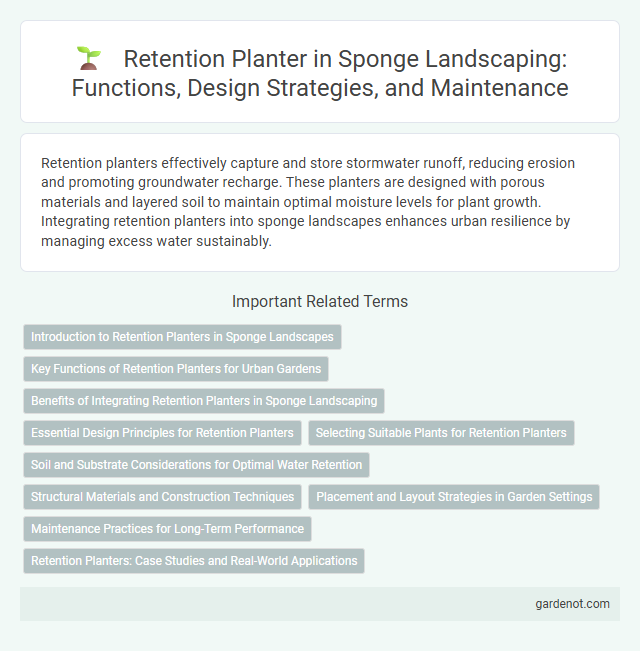Retention planters effectively capture and store stormwater runoff, reducing erosion and promoting groundwater recharge. These planters are designed with porous materials and layered soil to maintain optimal moisture levels for plant growth. Integrating retention planters into sponge landscapes enhances urban resilience by managing excess water sustainably.
Introduction to Retention Planters in Sponge Landscapes
Retention planters in sponge landscapes function as engineered systems designed to capture, store, and slowly release stormwater, reducing runoff and promoting groundwater recharge. These planters incorporate porous soil media and vegetation to enhance infiltration, improve water quality by filtering pollutants, and support urban biodiversity. Integrating retention planters helps cities manage stormwater sustainably, mitigating flood risks while creating green, functional urban spaces.
Key Functions of Retention Planters for Urban Gardens
Retention planters play a crucial role in urban gardens by efficiently capturing and storing stormwater, reducing runoff and preventing soil erosion. These planters enhance water retention in compact spaces, promoting healthier plant growth and improving groundwater recharge. Designed with permeable materials and integrated drainage systems, retention planters support sustainable urban water management and mitigate flooding risks.
Benefits of Integrating Retention Planters in Sponge Landscaping
Retention planters significantly enhance sponge landscaping by efficiently capturing and storing stormwater, reducing surface runoff, and promoting groundwater recharge. Their integration helps mitigate urban flooding, improves water quality by filtering pollutants, and supports local biodiversity through microhabitat creation. These benefits contribute to sustainable urban water management and resilient green infrastructure development.
Essential Design Principles for Retention Planters
Retention planters must incorporate permeable materials and proper soil composition to maximize water absorption and reduce runoff effectively. Strategic placement with graded slopes ensures optimal water retention while preventing overflow during heavy rainfall events. Integrating native plants with deep root systems enhances soil stability and promotes natural filtration, contributing to sustainable urban drainage.
Selecting Suitable Plants for Retention Planters
Selecting suitable plants for retention planters involves prioritizing species with high water absorption and pollutant filtration capacities to enhance stormwater management. Native grasses, sedges, and hardy perennials such as Carex, Juncus, and Echinacea thrive in fluctuating moisture conditions while supporting local biodiversity. Deep-rooted plants increase soil infiltration rates, reduce erosion, and promote long-term planter functionality in sponge landscapes.
Soil and Substrate Considerations for Optimal Water Retention
Retention planters require soil with high organic matter content and a well-balanced texture to enhance water-holding capacity while ensuring adequate aeration for root health. Incorporating substrates like coconut coir, peat moss, or biochar improves moisture retention and nutrient availability, optimizing plant growth. Proper soil composition reduces runoff and supports the sponge landscape's goal of efficient rainwater management and groundwater recharge.
Structural Materials and Construction Techniques
Retention planters in sponge landscape designs utilize porous concrete, recycled plastics, and geo-textiles to enhance water infiltration and retention. Advanced construction techniques include layer compaction and integrated drainage systems that prevent soil erosion and promote sustained moisture control. These materials and methods ensure durability and functionality in managing stormwater effectively within urban green infrastructure.
Placement and Layout Strategies in Garden Settings
Retention planters in sponge landscapes are strategically placed in low-lying garden areas to maximize stormwater capture and infiltration. Layout strategies emphasize proximity to impermeable surfaces, such as patios or driveways, to intercept runoff efficiently while integrating native vegetation that enhances water retention and soil health. Grouping multiple retention planters in a staggered pattern promotes gradual water absorption and reduces overflow, supporting sustainable garden water management.
Maintenance Practices for Long-Term Performance
Retention planters in sponge landscapes require regular inspection to remove sediment buildup and prevent clogging, ensuring optimal water infiltration and storage. Periodic pruning of surrounding vegetation maintains planter access and reduces debris accumulation, supporting effective stormwater management. Applying mulch replenishment enhances soil moisture retention and suppresses weed growth, contributing to the planter's long-term ecological function.
Retention Planters: Case Studies and Real-World Applications
Retention planters play a critical role in sustainable urban water management by capturing and slowly releasing stormwater runoff. Case studies in cities such as Portland and Singapore demonstrate how retention planters reduce flooding, improve water quality, and support local ecosystems by integrating vegetation and engineered substrates. Real-world applications confirm their efficiency in managing urban runoff while enhancing green infrastructure and promoting biodiversity.
Retention planter Infographic

 gardenot.com
gardenot.com